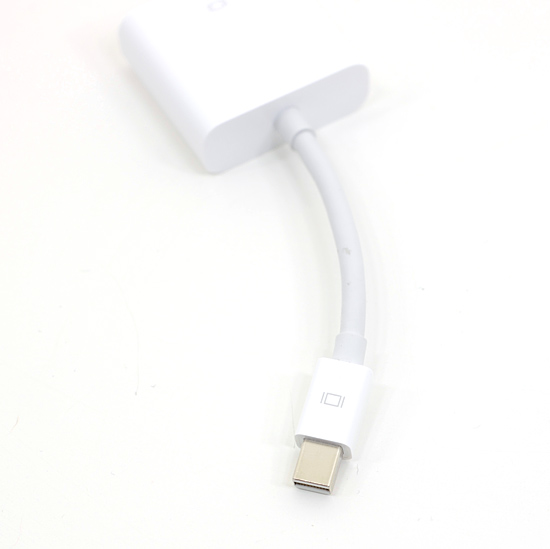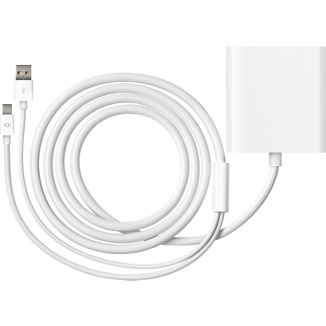Upgrading and Analyzing Apple's Nehalem Mac Pro
by Anand Lal Shimpi on July 13, 2009 5:00 PM EST- Posted in
- Mac
The Downside to Innovation
I’ve always appreciated Apple as a company because it isn’t afraid to completely ditch backwards compatibility in favor of embracing a new technology. For years Apple’s notebooks shipped with DVI ports on them and no direct VGA output. I loved it because I had DVI monitors, but that wasn’t true for everyone. Today Apple’s display interface of choice is mini DisplayPort:

Mini DisplayPort, to the left of the DVI port
It’s a cute little connector that we first saw Apple use on its updated MacBook and MacBook Pro. The benefit of the mini-DP connector is that it can easily be adapted to VGA or single-link DVI; adapter cable sold separately of course.
Since most users only have a single display, the new Mac Pro’s video card ships with both a dual-link DVI and a mini-DisplayPort output.
The mini DisplayPort output is just pure awesomeness.

Cute.
The mini-DP plug is just so much more pleasant than DVI or VGA connectors. There’s no annoying screws to worry about, just plug it in and the connector is secure. After using mini-DP on the Mac Pro I’m sold - I want one of these connectors on everything and I want monitors with mini-DP outputs.
It’s not all praise unfortunately. For starters, Apple doesn’t ship the Mac Pro with a mini-DP to DVI adapter. Given that there’s only one Apple display that uses mini-DP, it’s probably safe to say that next to no one has a mini-DP capable display. I’m all for early adoption of new technologies, but on a $3299 system just bundle the adapter ok?
The problems continue: natively this port will only drive a 1920 x 1200 panel, such as Apple’s 24” LED Cinema Display.
If you want to connect a single-link DVI display to the mini-DP port you need the adapter I showed in the picture above. Apple sells it for $30. It also comes in a VGA flavor.
If you want to connect a dual-link DVI monitor to the mini-DP output you need a different adapter:

This adapter draws power from the machine’s USB port. I’m guessing that there isn’t enough room/power to feed all of the DL-DVI pins from the mini DisplayPort connector so the adapter relies on USB to help out.
Reading through the customer reviews for this adapter it seems that many users are having compatibility issues with Apple’s mini-DP to DL-DVI converter with non-Apple displays. Not to mention that the adapter itself costs $99.
Between the high cost of the adapter and the high likelihood of problems, I’d suggest simply getting another video card if you want to have multiple 30” displays connected to your Mac Pro. Apple sells the GeForce GT 120 for $150 as an upgrade option, and at least with it each 30” display will be driven by its own frame buffer, which should make for smoother Exposé and Dashboard operation.










58 Comments
View All Comments
mfago - Monday, July 13, 2009 - link
Apple lists the Mac Pro as supporting DDR3 1066 only, yet the higher speed CPUs should support 1333. Have you tested this? I have an application that would love faster memory.Secondly, while Apple's prices are much higher than previous models (due to Intel's CPU prices, as you note), have you compared similar machines from Dell/HP? _Significantly_ more expensive: a T5500 with 2x2.93 GHz and 12 GB ram is $8000 (before discounts). Otherwise, the only way to get decent prices is through second/third tier vendors, or building one yourself. Sure CPU/RAM upgrades have always been this way, but Intel's extreme prices on Nehalem make this very obvious.
austin512 - Saturday, May 1, 2010 - link
Hi Anand,Any word on if the W3680 will work in the 2009 Mac Pro?
rominator - Thursday, July 22, 2010 - link
"While you could stick Clovertown into the first generation Mac Pros, you couldn’t upgrade them to Harpertown without hardware modifications to the system (don’t ask me what they are :)..)."AFAIK, nobody has ever discussed being able to do this. ANyone have an idea what he's referring to?
mrob27 - Thursday, September 23, 2010 - link
Upgrading CPUs:I have the 2.26 GHz 8-core model. I cannot afford to take the risk, but I'd love to upgrade it someday if it was less risky.
I think you should carefully measure the thickness of Xeon processors with and without the heat spreader (using an outside micrometer or something), and add washers to compensate for the needed spacing where the screws mate the heatsink to the processor board. This would properly relieve strain from the CPU package and allow you to tighten the hex nuts to the proper (standard) tension. Based on your photos it looks like that should work.
Turbo mode:
I was able to get valid convincing single-threaded benchmark results (demonstrating Turbo mode in action) by using the "Processor.prefPane" from Apple's Developer Tools. This is a System Preferences module that is placed in /Developer/Extras/PreferencePanes when you install the Dev Tools, and you copy it into /Library/PreferencePanes to enable it. Then use System Preferences to access it. You can turn off hyperthreading and can selectively disable any combination of cores 2-8 (#1 is always on). See for example goo.gl/7MZm or goo.gl/OH4K
- Robert Munafo - mrob.com/pub/comp/mac-models.html
Auralwiz - Friday, July 13, 2012 - link
Did you ever try the 2.26 8 core CPU upgrade?I tired two w35675s and failed to boot. Is there two big of a speed increase limit?
Michael
Highjnx - Sunday, November 7, 2010 - link
I recently tried to upgrade the E5520 procs in my 2009 Octo Nehalem with a set of X5560 (2.8GHz). I was able to get the machine to power up with no error lights. However I didn't get a chime and it refused to boot.In reading Anand's article on upgrading with a set of X5570 chips I didn't see any mention of the X5560 as an option. Is there something written into the bios that prevents this from posting.
The other thing I question is the added height created by the Integrated Heat Spreader doesn't give a solid connection between the daughter board and the heat sink fan plug. Has anyone run across a how-to on removing the IHS?
Any insight would be appreciated as I have access to several set's of X5560.
todd-
Auralwiz - Friday, July 13, 2012 - link
I purchased two w3565 LG 1366 processors for my 8 core dual 2.26 GHz 2009 Mac Pro 4,1.These CPUs are 3.2 Ghz.
The install was easy but the machine would not boot up. I re-installed the two 2.26 original CPUs and the system returned to normal. Any idea why it didn't work on an 8 core system?
I had the same experience as user Highjinx.
Michael
Soren4 - Sunday, June 12, 2016 - link
As a 2009 Mac Pro owner, I've followed the upgrade discussions for these machines carefully for some time. There appears to be a lot of discussion and instruction on how to swap out processors but usually involving lidded CPU's instead, which pose potential risks of damaging the motherboard in the process.I found an interesting video tutorial on Youtube today that clearly explains, while demonstrating, how to effectively remove the soldered IHS off the CPU, with the cleaning off of the solder, without damaging it.
It seems to me that this would be a lot easier to do than having to modify the heat sync pads and add washers etc., all the while allowing the processors to stay cooler due to the removal of the IHS.
Here is the link for review.
https://www.youtube.com/watch?v=aPhDfUkll-o
Thanks